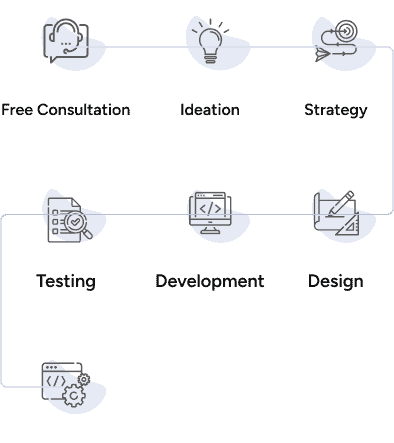Web Application Development Services
Trusted By Clients, Driven By Excellence For Two Decades
















Fingent’s Web Application Development Services
01 Custom Web Application Development
02 Web Application Modernization
03 Web Design Services
04 Open Source Web Development and Re-engineering
05 Web Application Support & Maintenance
01 Custom Web Application Development

Custom Web Application Development
We’re all about building tailor-made web apps just for you. Whether it’s a slick new app or a full-blown business platform, we’ve got the skills to make it happen.- Enterprise Web Apps
- Progressive Web Apps
- Digital Web Apps
- eCommerce Solutions
- Technology Consulting
02 Web Application Modernization

Web Application Modernization
Time for a tech facelift? We’ll spruce up your old web apps, bringing them into the modern age. Think faster, safer, and ready to tackle whatever the internet throws their way. We’ll help you garner better business profits from your existing applications with modern technology, framework, and security. Let Us Help You03 Web Design Services

Web Design Services
We can help you deliver a great online experience with a responsive web application or optimize your existing web design. We stay abreast of the latest trends to meet your web development needs and specifications.- Responsive Web Design
- UI/UX design
- Wireframe development
- Design prototypes
04 Open Source Web Development and Re-engineering

Open Source Web Development and Re-engineering
Why start from scratch? We leverage open-source technology to build or enhance your web presence efficiently. It’s like upgrading your home with top-quality tools – cost-effective and secure. Let Us Help You05 Web Application Support & Maintenance

Web Application Support & Maintenance
We specialize in keeping your web apps running smoothly. Consider us your dedicated IT team, on standby to address any issues promptly because operational web tools mean business success. Let Us Help YouOur Industrial Expertise For Web App Development
Financial Services
- Investment Banking
- Compliance Adherence Software
- Secure Transaction Platforms
- Cards and payments
Real Estate
- Property investment
- Facility management
- Property acquisition
- Construction and development
Education
- Online Learning Platforms
- Student Management Systems
- Educational Resource Platforms
Manufacturing
- Smart manufacturing operations
- Inventory Tracking Systems
- Supply Chain Management Solutions
Retail
- Supply Chain management
- Omnichannel Fulfillment
- Loyalty and Promotions
- Payment Security
Logistics
- Fleet Management
- Supply Chain Operations
- Warehouse Management
- Manpower Management
Utilities
- Work Management
- Smart Grid Operations
- Robotic Process Automation
- Industrial Internet of Things (IIoT)
Healthcare
- Electronic health records (EHR)
- Appointment management system
- Health information exchanges (HIE)
Media
- Video and Audio Analytics
- Digital Publishing Platforms
- Audience Engagement Tools
Sports
- Team Management Platforms
- Fan Engagement Applications
- Athlete Performance Tracking Systems
Non-profits
- Donor Management Systems
- Fundraising Platforms
- Volunteer Management Software
Travel
- Booking and Reservation Systems
- Travel Management Platforms
- Destination Information Portals
AI-powered Web Application Development Services


Chatbots

Intelligent Automation

Predictive Analytics

Cybersecurity

Voice Search Optimization

Image Recognition

Chatbots
Chatbots are like your 24/7 virtual assistants. They handle customer inquiries, provide instant support, and streamline interactions.

Intelligent Automation
Intelligent automation takes care of repetitive tasks, freeing up your team to focus on more important matters.

Predictive Analytics
Predictive Analytics plays with numbers and spot trends, helping you make informed decisions before they happen.

Cybersecurity
Cybersecurity safeguards web applications from cyber threats, including unauthorized access, data breaches, and malware attacks.

Voice Search Optimization
Enhances web app visibility and accessibility on voice-enabled devices by optimizing content and structure to match voice search queries.

Image Recognition
Analyze and interpret visual content, enabling web applications to identify objects, patterns, and context within images.
The Fingent Way of Building Your Web Application




Fingent, The Trusted Custom Software Development Company


Take a Glimpse of Our Client Voices
5.0
"I’ve felt that I have a real partner in this work since Fingent came in on day one with a comprehensive plan."
VP of Technology & Innovation, Impact XM
5.0
"I like the quality of their deliverables, the timeliness with which they deliver, and the budget."
Co-Founder & CTO, Chemical Safety Software Developer
5.0
"We have complete confidence in the team and plan to use them for years to come."
Director, Trade Alliance Group
5.0
“I was very amazed by what they managed to pull off from my description of our software.”
CEO, Spectrum Exchange Corporation
5.0
"Their team’s knowledgeable, responsive, and professional."
Owner & Director, Mohawk Day Camp
5.0
“I’ve never wondered if somebody else could have done it better, faster, or cheaper.”
Partner, Sapra & Navarra, LLP
5.0
“Their team is completely committed to our success as a client, and they do that with their dynamic team.”
Principal, Substantive Solutions
5.0
"We had a very complex thing that we had to break down, and they made it very easy."
Chief Creative Officer, Eskoa
5.0
“Beyond their reasonable price structure and technical knowledge, their team is reliable and productive.”
Technical Director, Click n Collect Pty Ltd
More Insights on Web Application Development

Web Application
Web Application Development: A Detailed Guide
A decade ago, web pages were mostly static, with a few images and videos thrown in here and there. In 2005, however, thanks to Ajax, it made it possible to create better, faster, and more interactive web applications.
Read More
Web Application
Top Technologies Used to Develop Mobile Apps
Business mobile applications are a must-have for reaching diverse audiences and making immense fortune in today’s digital-savvy market. Enterprise mobile apps help you achieve more than what you could with a run-of-the-mill website or a legacy desktop software.
Read More
Web Application
Types of Application Software: Guide
Application software has become our everyday companions, knowingly or unknowingly. Today, various application software types are available to suit every need and purpose. Picking the right application software for your personal use or business can significantly impact you.
Read More














































